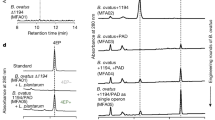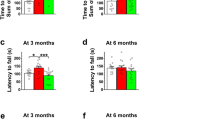Abstract
Glyphosate is a widely used active ingredient in agricultural herbicides, inhibiting the biosynthesis of aromatic amino acids in plants by targeting their shikimate pathway. Our gut microbiota also facilitates the shikimate pathway, making it a vulnerable target when encountering glyphosate. Dysbiosis in the gut microbiota may impair the gut–brain axis, bringing neurological outcomes. To evaluate the neurotoxicity and biochemical changes attributed to glyphosate, we exposed mice with the reference dose (RfD) set by the U.S. EPA (1.75 mg/Kg-BW/day) and its hundred-time-equivalence (175 mg/Kg-BW/day) chronically via drinking water, then compared a series of neurobehaviors and their fecal/serum metabolomic profile against the non-exposed vehicles (n = 10/dosing group). There was little alteration in the neurobehavior, including motor activities, social approach, and conditioned fear, under glyphosate exposure. Metabolomic differences attributed to glyphosate were observed in the feces, corresponding to 68 and 29 identified metabolites with dysregulation in the higher and lower dose groups, respectively, compared to the vehicle-control. There were less alterations observed in the serum metabolome. Under 175 mg/Kg-BW/day of glyphosate exposure, the aromatic amino acids (phenylalanine, tryptophan, and tyrosine) were reduced in the feces but not in the serum of mice. We further focused on how tryptophan metabolism was dysregulated based on the pathway analysis, and identified the indole-derivatives were more altered compared to the serotonin and kynurenine derivatives. Together, we obtained a three-dimensional data set that records neurobehavioral, fecal metabolic, and serum biomolecular dynamics caused by glyphosate exposure at two different doses. Our data showed that even under the high dose of glyphosate irrelevant to human exposure, there were little evidence that supported the impairment of the gut–brain axis.





Similar content being viewed by others
Data availability
Data are available from the corresponding author upon reasonable request.
References
Ait Bali Y, Ba-Mhamed S, Bennis M (2017) Behavioral and immunohistochemical study of the effects of subchronic and chronic exposure to glyphosate in mice. Front Behav Neurosci. https://doi.org/10.3389/fnbeh.2017.00146
Aitbali Y, Ba-M’hamed S, Elhidar N, Nafis A, Soraa N, Bennis M (2018) Glyphosate based- herbicide exposure affects gut microbiota, anxiety and depression-like behaviors in mice. Neurotoxicol Teratol 67:44–49. https://doi.org/10.1016/j.ntt.2018.04.002
Boocock MR, Coggins JR (1983) Kinetics of 5-enolpyruvylshikimate-3-phosphate synthase inhibition by glyphosate. FEBS Lett 154(1):127–133. https://doi.org/10.1016/0014-5793(83)80888-6
Brammer A (2001) Glyphosate acid: Two year dietary toxicity and oncogenicity study in rats. Unpublished report No. CTL/PR1111, study No. PR1111. Zeneca Agrochemicals, Central Toxicology Laboratory, Alderley Park, Macclesfield
Chaleckis R, Meister I, Zhang P, Wheelock CE (2019) Challenges, progress and promises of metabolite annotation for LC-MS-based metabolomics. Curr Opin Biotechnol 55:44–50. https://doi.org/10.1016/j.copbio.2018.07.010
Costas-Ferreira C, Durán R, Faro LRF (2022) Toxic effects of glyphosate on the nervous system: a systematic review. Int J Mol Sci. https://doi.org/10.3390/ijms23094605
Defarge N, Takács E, Lozano VL et al (2016) Co-formulants in glyphosate-based herbicides disrupt aromatase activity in human cells below toxic levels. Int J Environ Res Public Health. https://doi.org/10.3390/ijerph13030264
Giommi C, Ladisa C, Carnevali O, Maradonna F, Habibi HR (2022) Metabolomic and transcript analysis revealed a sex-specific effect of glyphosate in zebrafish liver. Int J Mol Sci. https://doi.org/10.3390/ijms23052724
Guo H, Chou W-C, Lai Y et al (2020) Multi-omics analyses of radiation survivors identify radioprotective microbes and metabolites. Science 370(6516):eaay9097. https://doi.org/10.1126/science.aay9097
Hernández-Plata I, Giordano M, Díaz-Muñoz M, Rodríguez VM (2015) The herbicide glyphosate causes behavioral changes and alterations in dopaminergic markers in male Sprague-Dawley rat. Neurotoxicology 46:79–91. https://doi.org/10.1016/j.neuro.2014.12.001
Hsiao Y-C, Liu C-W, Robinette C, Knight N, Lu K, Rebuli ME (2022) Development of LC-HRMS untargeted analysis methods for nasal epithelial lining fluid exposomics. J Eposure Sci Environ Epidemiol. https://doi.org/10.1038/s41370-022-00448-3
Hu J, Lesseur C, Miao Y et al (2021) Low-dose exposure of glyphosate-based herbicides disrupt the urine metabolome and its interaction with gut microbiota. Sci Rep 11(1):3265. https://doi.org/10.1038/s41598-021-82552-2
Lai Y, Liu C-W, Yang Y, Hsiao Y-C, Ru H, Lu K (2021) High-coverage metabolomics uncovers microbiota-driven biochemical landscape of interorgan transport and gut-brain communication in mice. Nat Commun 12(1):6000. https://doi.org/10.1038/s41467-021-26209-8
Lozano VL, Defarge N, Rocque L-M et al (2018) Sex-dependent impact of Roundup on the rat gut microbiome. Toxicol Rep 5:96–107. https://doi.org/10.1016/j.toxrep.2017.12.005
Mao Q, Manservisi F, Panzacchi S et al (2018) The Ramazzini Institute 13-week pilot study on glyphosate and roundup administered at human-equivalent dose to Sprague Dawley rats: effects on the microbiome. Environ Health 17(1):50. https://doi.org/10.1186/s12940-018-0394-x
Martínez MA, Ares I, Rodríguez JL, Martínez M, Martínez-Larrañaga MR, Anadón A (2018) Neurotransmitter changes in rat brain regions following glyphosate exposure. Environ Res 161:212–219. https://doi.org/10.1016/j.envres.2017.10.051
Mesnage R, Antoniou MN (2020) Computational modelling provides insight into the effects of glyphosate on the shikimate pathway in the human gut microbiome. Curr Res Toxicol 1:25–33. https://doi.org/10.1016/j.crtox.2020.04.001
Mesnage R, Benbrook C, Antoniou MN (2019) Insight into the confusion over surfactant co-formulants in glyphosate-based herbicides. Food Chem Toxicol 128:137–145. https://doi.org/10.1016/j.fct.2019.03.053
Moser VC, Morris-Schaffer K, Richardson JR, Li AA (2022) Glyphosate and neurological outcomes: a systematic literature review of animal studies. J Toxicol Environ Health Part B 25(4):162–209. https://doi.org/10.1080/10937404.2022.2083739
Motta EVS, Raymann K, Moran NA (2018) Glyphosate perturbs the gut microbiota of honey bees. Proc Natl Acad Sci U S A 115(41):10305–10310. https://doi.org/10.1073/pnas.1803880115
Nielsen LN, Roager HM, Casas ME et al (2018) Glyphosate has limited short-term effects on commensal bacterial community composition in the gut environment due to sufficient aromatic amino acid levels. Environ Pollut 233:364–376. https://doi.org/10.1016/j.envpol.2017.10.016
Nufarm (2009) Glyphosate technical: dietary com-bined chronic toxicity/carcinogenicity study in the rat. Project Number: 2060–0012. Nufarm Asia Sdn Bhd
Portier CJ (2020) A comprehensive analysis of the animal carcinogenicity data for glyphosate from chronic exposure rodent carcinogenicity studies. Environ Health 19(1):18. https://doi.org/10.1186/s12940-020-00574-1
Saad AK, Akour A, Mahboob A, AbuRuz S, Sadek B (2022) Role of Brain modulators in neurodevelopment: focus on autism spectrum disorder and associated comorbidities. Pharmaceuticals (Basel). https://doi.org/10.3390/ph15050612
Samsel A, Seneff S (2013) Glyphosate’s suppression of cytochrome P450 enzymes and amino acid biosynthesis by the gut microbiome: pathways to modern diseases. Entropy. https://doi.org/10.3390/e15041416
Shehata A, Schrödl W, Alnassan A, Hafez H, Krueger M (2012) The effect of glyphosate on potential pathogens and beneficial members of poultry microbiota in vitro. Curr Microbiol. https://doi.org/10.1007/s00284-012-0277-2
Soares D, Silva L, Duarte S, Pena A, Pereira A (2021) Glyphosate use toxicity and occurrence in food. Foods 10(11):2785
Strandwitz P (2018) Neurotransmitter modulation by the gut microbiota. Brain Res 1693(Pt B):128–133. https://doi.org/10.1016/j.brainres.2018.03.015
Straw EA, Brown MJF (2021) Co-formulant in a commercial fungicide product causes lethal and sub-lethal effects in bumble bees. Sci Rep 11(1):21653. https://doi.org/10.1038/s41598-021-00919-x
Williams GM, Kroes R, Munro IC (2000) Safety evaluation and risk assessment of the herbicide Roundup and its active ingredient, glyphosate, for humans. Regul Toxicol Pharmacol 31(2 Pt 1):117–165. https://doi.org/10.1006/rtph.1999.1371
Zabalza A, Orcaray L, Fernández-Escalada M, Zulet-González A, Royuela M (2017) The pattern of shikimate pathway and phenylpropanoids after inhibition by glyphosate or quinate feeding in pea roots. Pestic Biochem Physiol 141:96–102. https://doi.org/10.1016/j.pestbp.2016.12.005
Zoller O, Rhyn P, Zarn JA, Dudler V (2020) Urine glyphosate level as a quantitative biomarker of oral exposure. Int J Hyg Environ Health 228:113526. https://doi.org/10.1016/j.ijheh.2020.113526
Funding
The research was supported by the UNC Superfund Research program (P42ES031007), University of North Carolina Center for Environmental Health and Susceptibility grant (P30ES010126), and by the UNC Intellectual and Developmental Disabilities Research Center (NICHD; P50 HD103573; PI: Gabriel Dichter).
Author information
Authors and Affiliations
Corresponding author
Ethics declarations
Conflict of interest
The authors declare that they have no actual or potential competing financial interests.
Additional information
Publisher's Note
Springer Nature remains neutral with regard to jurisdictional claims in published maps and institutional affiliations.
Supplementary Information
Below is the link to the electronic supplementary material.
Rights and permissions
Springer Nature or its licensor (e.g. a society or other partner) holds exclusive rights to this article under a publishing agreement with the author(s) or other rightsholder(s); author self-archiving of the accepted manuscript version of this article is solely governed by the terms of such publishing agreement and applicable law.
About this article
Cite this article
Hsiao, YC., Johnson, G., Yang, Y. et al. Evaluation of neurological behavior alterations and metabolic changes in mice under chronic glyphosate exposure. Arch Toxicol 98, 277–288 (2024). https://doi.org/10.1007/s00204-023-03622-0
Received:
Accepted:
Published:
Issue Date:
DOI: https://doi.org/10.1007/s00204-023-03622-0




